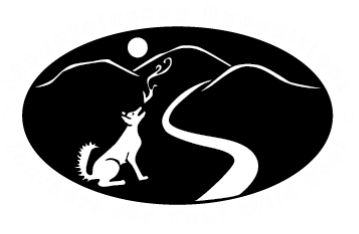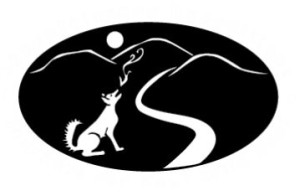
Following through on my desire to be in the woods more mindfully, I recently journeyed to Mountainsong Expeditions in Worcester, Vermont, to attend a Sacred Huntress Intensive taught by Mary “Murphy” Robinson. I’d met Murphy (yes, that’s what she prefers to be called) at Winter Doe Camp last March, and immediately liked her calm demeanor, deep knowledge, and spiritual approach to being in nature. Honestly, I’m a bit anxious about stepping off the blazed trail, so Murphy’s reassuring presence helped me become more comfortable off the beaten path and more aware of what’s going on in the woods. It only made sense to continue past what she taught at Doe Camp and try one of her regular, more comprehensive courses.
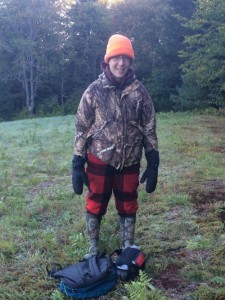
I wasn’t alone in that desire: there were five women enrolled, ranging in age from 16 to 60. Of these, only Maya, a 16-year old from Montana, was an experienced hunter; she came with her Aunt Sheila, who’s lived in Vermont for years and wanted to learn with her niece. Deborah, a former Outward Bound instructor who now teaches at a wilderness school in western Massachusetts, came to the intensive with the intention of connecting to her past by keeping alive the hunting knowledge and skill of her ancestors. Erin, a mother of two young children who had just moved from California to Vermont, came to connect to the land she now inhabits, and to learn new skills.
We had two instructors. Murphy, originally from Maine, has tremendous outdoor experience from working trail maintenance out west, doing seasonal work in an apple orchard, hiking the AT, and living lightly on the land. Even though she’s only been hunting for six or so years, she has a deep knowledge of the natural world. Eric Garza shared his field-craft expertise with generosity and kindness. Originally from the Midwest, he’s been hunting for about nine years, mostly with a bow.
Of the seven of us (including the instructors), I’d lived in Vermont longest – and after all that time, I’m as surprised as anyone by my new interest in hunting. But, I’ve learned to follow whatever tugs at my heart. After more than thirty years tilling the soil and raising animals for the table, I’m ready to discover the animals the land raises, and to learn more deeply this place I call home by finding my way in the woods.
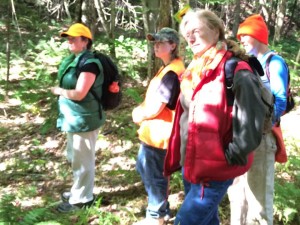
Starting at nine Saturday morning and concluding mid-afternoon on Sunday, we alternated between spoken and experiential instruction. Our classroom was a circle of logs with a breathtaking view of the Worcester Range in the west, complete with the silhouette of the Camel’s Hump distinct profile in a notch to the south. We were blessed with fantastic fall weather of cool (okay, cold) nights and warm days. We watched the Blood Moon, just a night shy of full, rise over our Saturday night fire circle, and we watched it set just as we headed out on a mock hunt Sunday morning before dawn. Aside from the few hours we slept in our tents, we were outdoors for the entire Intensive.
All the experiential learning episodes began in our circle, where Murphy explained the exercise and what to expect. Afterwards, we’d process what we’d just learned, both in our hearts and minds, so that we could integrate these lessons into our whole selves.
The Experience Of Hunting: Reading The Landscape
The two sessions I liked best were the ones that taught me new ways to interpret the landscape: scouting deer sign and a mock hunt at daybreak.
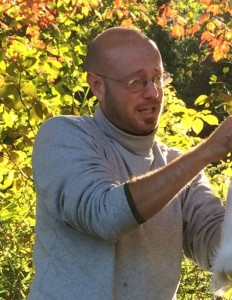
We scouted for deer in a town forest a few miles from base camp. Before entering the woods we imaginatively transformed ourselves into deer and spent a few minutes inhabiting the forest verge as if we were Odocoileus virginianus, better known as the white-tail deer. While grown-ups typically roll their eyes at such play, I found it a remarkable way to recalibrate my mind to seeing the woods from a deer’s point of view. I was rewarded with the sighting of a garter snake whose movement I noticed with my deer eyes, which see less color and more movement.
We returned to our human form and followed a snowmobile trail over a rise, through a bog, and to what Eric called “a kitchen” – where deer go to browse. What before I would have dismissed as a low-lying, bramble-filled clearing I now saw as a well-stocked pantry, filled with browse. We followed a “hallway” from the kitchen to a rise of hemlock, the “bedroom” where we could still make out the depressions of deer beds. Anthropomorphizing how the deer use the forest helped me make sense of what I previously perceived as mere randomness.
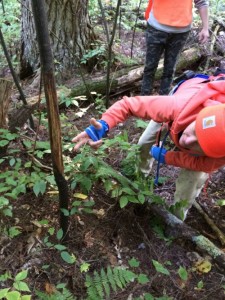
We found rubs – where male deer had rubbed their antlers against young striped maple saplings– and we noticed how they occurred at the margins, where one type of forest met another, near where the hallway entered the bedroom. We also looked for scrapes, where males clear a patch of ground which they mark with urine to announce their readiness to meet any interested females and to warn other males off their turf.
By the time I walked out of the woods, I could see organization and meaning where previously I saw only the illegible tangle of underbrush. I was learning to read the landscape.
The Experience Of Hunting: A Mock Hunt
But reading the woods is more than looking for signs, as I learned during our mock hunt the next morning. We prepared to walk to a nearby field under the light of the setting moon, and followed Murphy single file from our tent site through the woods. When we arrived, we separated, each finding a spot along a stonewall in which to sit and watch.
With the moon set and the sun not yet out, there was little to see – and lots to hear. First, I heard a distant rooster sounding the daybreak alarm. Closer, I heard increasing traffic on Route 12. I heard an owl say goodnight and geese honk good day. With my ears opened to the moment, I heard coyotes, turkeys, crows, a red squirrel and blue jays. I heard the music of the woods.
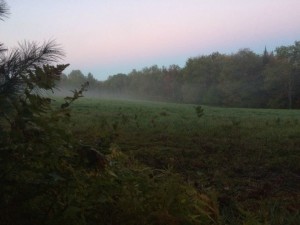
From my position, I didn’t see Eric appear as a deer, though I did hear Murphy yell, “Bang!” The “deer” disappeared, and after thirty minutes, we followed the blood trail until we found him. It was a great way to put into practice some of the theory we’d been learning, and a chance to experience starting the day both in the woods and in the dark. I still don’t know if I’ll ever shoot a deer; I do know for sure I’ll make more of an effort to be outside both in the dawn and the dark, which sharpens my senses.
One of the reasons I still don’t know if I’ll ever shoot a deer is because I’m not yet a good shot. I found rifle practice more challenging this time than it was at Doe Camp, where I hit a cluster of bulls-eyes on a target in clear view at twenty-five yards. This time, the conditions were more realistic to deer hunting: the target was farther away, the leaves on the trees turned the sunlight to shadows, and there was just a narrow corridor through the trees from where I crouched to the target. Ever since Doe Camp, I’ve known I needed target practice, and I have experienced friends who’ve agreed to take me to a range. But I haven’t gone yet, which testifies not just to my busy life, but also to my continued ambivalence toward firearms. Not so Erin, who’d never shot a gun before in her life. She liked it – a lot.
The Experience Of Hunting: The Kill
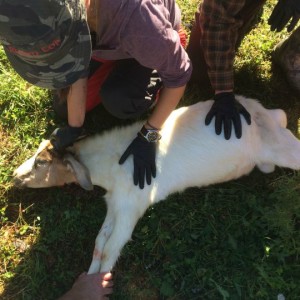
A well-advertised part of the intensive was the Sacred Goat Slaughter, for which Maya and Sheila didn’t stay. Murphy reported that Maya finds the slaughter of domestic animals immoral, which is a new twist (for me) to the complexity of food ethics.
Murphy then taught our smaller group a chant that we’d sing to calm the animal and ourselves. There’s no way around it: killing an animal is a Big Deal, and even under the most humane and ethical standards, a violent act. According to Murphy, it’s easier emotionally to shoot a deer at eighty feet than to slaughter a goat up close and personal.
Which we did.
And then we took it apart, bit-by-bit, and saved almost every usable bit. Eric skinned the hide and harvested the organs, including the gut casings. Murphy showed us how to break down the carcass into recognizable joints of meat. In a matter of hours, the live billy goat was reduced to useable component parts and meat.
We followed this experience with a Shamanic Journey to help process the goat’s sacrifice and our part in it. Guided by Murphy’s drum and prompts, we metaphysically traveled to a place where we could encounter the goat’s spirit. What each person found on this journey, as well as the content of our discussion of spirituality and the hunt around the fire on Saturday night, is not for me to recount; I can only say that the revelations were profound.
The motto for Mountainsong Expeditions is “Journeys for Your Wild Soul.” I always thought my wild soul would roar and growl, but if it’s my wild soul I plumbed Saturday night, with my companion huntresses to bear witness, then I’m here to say that my wildness comes not from ferocity or blood lust, but from a deeper understanding that life takes place on a thin edge, surrounded by death. It’s from this place of heightened awareness that I’m finding a new way to be in the woods.
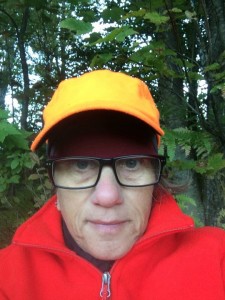
Upcoming classes at Mountainsong Expeditions include a mixed-gender Sacred Hunt class, a class in hide tanning, and a class in Venison Cookery. The school’s year ends in November with a guided deer hunt in North Carolina. This is as good a way as I can imagine for a non-hunter to explore the idea of finding the hunter within.
Deborah Lee Luskin has spent a lifetime hunting for the right words to tell stories. She’s as surprised as anyone to find herself learning the vocabulary of the woods in pursuit of the hunt, which is a story at least as old as humans themselves. Learn more at www.deborahleeluskin.com


